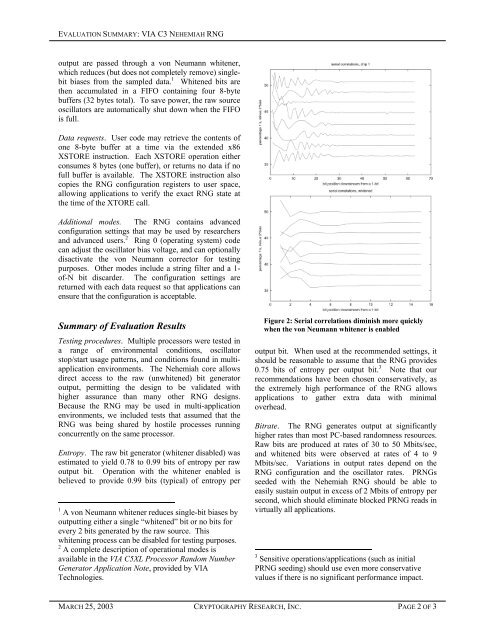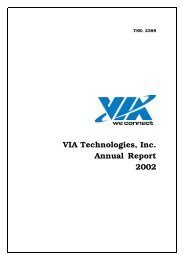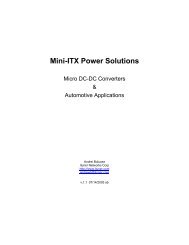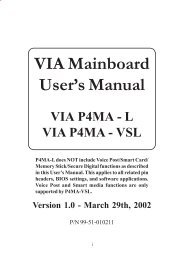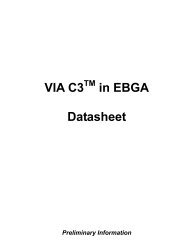via c3 nehemiah random number generator - VIA Technologies, Inc.
via c3 nehemiah random number generator - VIA Technologies, Inc.
via c3 nehemiah random number generator - VIA Technologies, Inc.
Create successful ePaper yourself
Turn your PDF publications into a flip-book with our unique Google optimized e-Paper software.
EVALUATION SUMMARY: <strong>VIA</strong> C3 NEHEMIAH RNG<br />
output are passed through a von Neumann whitener,<br />
which reduces (but does not completely remove) singlebit<br />
biases from the sampled data. 1 Whitened bits are<br />
then accumulated in a FIFO containing four 8-byte<br />
buffers (32 bytes total). To save power, the raw source<br />
oscillators are automatically shut down when the FIFO<br />
is full.<br />
Data requests. User code may retrieve the contents of<br />
one 8-byte buffer at a time <strong>via</strong> the extended x86<br />
XSTORE instruction. Each XSTORE operation either<br />
consumes 8 bytes (one buffer), or returns no data if no<br />
full buffer is available. The XSTORE instruction also<br />
copies the RNG configuration registers to user space,<br />
allowing applications to verify the exact RNG state at<br />
the time of the XTORE call.<br />
Additional modes. The RNG contains advanced<br />
configuration settings that may be used by researchers<br />
and advanced users. 2 Ring 0 (operating system) code<br />
can adjust the oscillator bias voltage, and can optionally<br />
disactivate the von Neumann corrector for testing<br />
purposes. Other modes include a string filter and a 1of-N<br />
bit discarder. The configuration settings are<br />
returned with each data request so that applications can<br />
ensure that the configuration is acceptable.<br />
Summary of Evaluation Results<br />
Testing procedures. Multiple processors were tested in<br />
a range of environmental conditions, oscillator<br />
stop/start usage patterns, and conditions found in multiapplication<br />
environments. The Nehemiah core allows<br />
direct access to the raw (unwhitened) bit <strong>generator</strong><br />
output, permitting the design to be validated with<br />
higher assurance than many other RNG designs.<br />
Because the RNG may be used in multi-application<br />
environments, we included tests that assumed that the<br />
RNG was being shared by hostile processes running<br />
concurrently on the same processor.<br />
Entropy. The raw bit <strong>generator</strong> (whitener disabled) was<br />
estimated to yield 0.78 to 0.99 bits of entropy per raw<br />
output bit. Operation with the whitener enabled is<br />
believed to provide 0.99 bits (typical) of entropy per<br />
1 A von Neumann whitener reduces single-bit biases by<br />
outputting either a single “whitened” bit or no bits for<br />
every 2 bits generated by the raw source. This<br />
whitening process can be disabled for testing purposes.<br />
2 A complete description of operational modes is<br />
available in the <strong>VIA</strong> C5XL Processor Random Number<br />
Generator Application Note, provided by <strong>VIA</strong><br />
<strong>Technologies</strong>.<br />
Figure 2: Serial correlations diminish more quickly<br />
when the von Neumann whitener is enabled<br />
output bit. When used at the recommended settings, it<br />
should be reasonable to assume that the RNG provides<br />
0.75 bits of entropy per output bit. 3 Note that our<br />
recommendations have been chosen conservatively, as<br />
the extremely high performance of the RNG allows<br />
applications to gather extra data with minimal<br />
overhead.<br />
Bitrate. The RNG generates output at significantly<br />
higher rates than most PC-based <strong>random</strong>ness resources.<br />
Raw bits are produced at rates of 30 to 50 Mbits/sec,<br />
and whitened bits were observed at rates of 4 to 9<br />
Mbits/sec. Variations in output rates depend on the<br />
RNG configuration and the oscillator rates. PRNGs<br />
seeded with the Nehemiah RNG should be able to<br />
easily sustain output in excess of 2 Mbits of entropy per<br />
second, which should eliminate blocked PRNG reads in<br />
virtually all applications.<br />
3 Sensitive operations/applications (such as initial<br />
PRNG seeding) should use even more conservative<br />
values if there is no significant performance impact.<br />
MARCH 25, 2003 CRYPTOGRAPHY RESEARCH, INC. PAGE 2 OF 3


